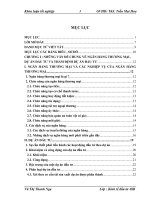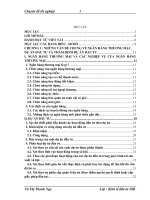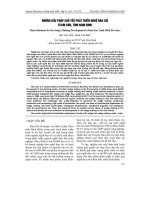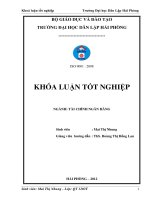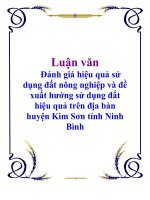Attitude towards sea of residents in Kim Son District, Ninh Binh Province
Bạn đang xem bản rút gọn của tài liệu. Xem và tải ngay bản đầy đủ của tài liệu tại đây (306.82 KB, 14 trang )
Attitude towards sea of residents in Kim Son
District, Ninh Binh Province
Bùi Cẩm Phượng
Viện Việt Nam học và Khoa học phát triển
Luận văn ThS ngành: Việt Nam học; Mã số:
Người hướng dẫn: 60 22 01 13
Năm bảo vệ: 2013
Keywords. Việt Nam học; Văn hóa ứng xử; Hành vi ứng xử; Cư dân vùng biển; Ninh
Bình
Content
ATTIDUTE TOWARDS SEA OF RESIDENTS
IN KIM SON DISTRICT, NINH BINH PROVINCE BUI CAM PHUONG
____________________________________
____________________________________
INSTITUTE OF VIETNAMESE STUDIES AND DEVELOPMENT SCIENCES
VIETNAM NATIONAL UNIVERSITY, HANOI
- 5 -
TABLE OF CONTENTS
TABLE OF CONTENTS 1
INTRODUCTION 8
1. Rationale for the research 8
2. Setting of the scene 9
3. Research subject and scope 11
3.1. Research subject 11
3.2. Research scope 11
4. Methodology 11
5. Contribution of the thesis 11
6. Structure of the thesis 12
CONTENT 13
CHAPTER 1: GENERAL OVERVIEW OF KIM SON DISTRICT,
NINH BINH PROVINCE 13
1.1. Natural conditions 13
1.2. Social, historical, economic and cultural elements of Kim Son
District, Ninh Binh Province 18
1.2.1. History of formation of Kim Son District, Ninh Binh Province 18
ATTIDUTE TOWARDS SEA OF RESIDENTS
IN KIM SON DISTRICT, NINH BINH PROVINCE BUI CAM PHUONG
____________________________________
____________________________________
INSTITUTE OF VIETNAMESE STUDIES AND DEVELOPMENT SCIENCES
VIETNAM NATIONAL UNIVERSITY, HANOI
- 6 -
1.2.2. Social, economic and cultural elements of Kim Son district 20
Sub-conclusion of Chapter 1 24
CHAPTER 2: HUMAN BEHAVIOUR TOWARDS THE SEA IN KIM
SON DISTRICT, NINH BINH PROVINCE 26
2.1. Definition of behaviour 26
2.2. Adaptation to the sea of habitants in Kim Son District, Ninh Binh
province 28
2.2.1. Process of establishment of production and living materials of
habitants in Kim Son District, Ninh Binh province 28
2.2.1.1. The process of constructing sea dykes and encroaching on the
sea 30
2.2.1.2. The occupations of Kim Son, Ninh Binh in relation to sea 63
2.2.2. Organization of social and cultural of Kim Son inhabitants in Ninh
Binh province 75
2.2.2.1. Social organization - the traditional culture of Kim Son
inhabitants in Ninh Binh province 76
2.2.2.2. Current social organization 92
Sub-conclusion of Chapter 2 94
CHAPTER 3: THE VALUE AND REAL SIGNIFICANCE OF THE
BEHAVIOR TOWARDS THE SEA 97
3.1. The value and significance of constructing sea dykes and encroaching
on the sea 97
3.2. The value and significance of sidelines and trade villages 101
ATTIDUTE TOWARDS SEA OF RESIDENTS
IN KIM SON DISTRICT, NINH BINH PROVINCE BUI CAM PHUONG
____________________________________
____________________________________
INSTITUTE OF VIETNAMESE STUDIES AND DEVELOPMENT SCIENCES
VIETNAM NATIONAL UNIVERSITY, HANOI
- 7 -
3.3. Value and significance of organizing ways of social and cultural life
103
Sub-conclusion of Chapter 3 106
CONCLUSION 107
REFERENCES 110
APPENDIX 115
ATTIDUTE TOWARDS SEA OF RESIDENTS
IN KIM SON DISTRICT, NINH BINH PROVINCE BUI CAM PHUONG
____________________________________
____________________________________
INSTITUTE OF VIETNAMESE STUDIES AND DEVELOPMENT SCIENCES
VIETNAM NATIONAL UNIVERSITY, HANOI
- 8 -
INTRODUCTION
1. Rationale for the research
Vietnam is a country which has 330.991km
2
of land and 3260km of
coastline. There are about 20 million people who make livelihood closely to
the sea from long time ago. Thus, the sea takes an important role in economic,
political and cultural life in Vietnam.
Towards the sea, from ancient times, the Vietnamese often behave in
two ways: Firstly, dyking and sea encroaching for agricultural production;
secondly, understanding the sea to make livelihood in connection with
fishing… Both these kinds of behaviours are covered in our research on
human behaviour towards the sea in Kim Son District, Ninh Binh province.
The establishment of Kim Son district, Ninh Binh province in Nguyen
dynasty, during the reign of Minh Mang Emperor, adhered to Nguyen Cong
Tru, the Great Man of “doanh dien” - a kind of land which was used both for
civil and military purposes, is a proof of the first way of behaviour to improve
wild swamps or dry lands to fertile and productive places for growing wet rice
and developing wealthy villages.
Towards the sea, people understand enormous values of the sea,
therefore, they do not only make use of the sea in two mentioned ways but
also create specialities from sea food such as shrimps, crabs, fishes, clams,
cockles… to serve themselves. Those above –mentioned values are deeply
attached to each other. As a result of this, the research on the coastal area of
Kim Son, in nature, is exploring behaviours of the people living there towards
the sea in those two aspects.
ATTIDUTE TOWARDS SEA OF RESIDENTS
IN KIM SON DISTRICT, NINH BINH PROVINCE BUI CAM PHUONG
____________________________________
____________________________________
INSTITUTE OF VIETNAMESE STUDIES AND DEVELOPMENT SCIENCES
VIETNAM NATIONAL UNIVERSITY, HANOI
- 9 -
This research also aims to understanding the behaviour of resident
community developed by encroaching the sea - a typical feature of this area.
For more than 2 centuries since the formation, Kim Son area has changed
completely, the culture of local people like a cloth of which fabric - wet rice
culture has dyed with sea culture. To this point, the sea does not only bring
living resources to the people but also play an important role to cultural,
spiritual lives of local people (faiths, religions and beliefs).
2. Setting of the scene
In current years, there are many research on the sea, especially on sea
culture and people who living close to the sea. These works use many
different scientific approaches, from natural sciences such as ecology,
environmentology, pedology, climatology of coastal area to history,
culturology and anthropology… However, it is very few research on the area
of Kim Son, Ninh Binh. In order to make it clearer, from scientific
perspective, we would like to review some research relating to this research’
topic which is about local people and sea culture in Kim Son, Ninh Binh.
Amongst the works on Kim Son, first, the one focuses on the history of
this area and the process of breaking the area. In the book “The process of
breaking fresh land to form Kim Son district” (Ky Suu 1829), the author Dao
To Uyen - Nguyen Canh Minh wrote about the process of breaking fresh land
to establish villages, participating forces, techniques and the results of this
process in the area of Kim Son, and simultaneously helped us to understand
more on the kind of breaking land to form “doanh dien” under Nguyen
dynasty including the process of formation of Tien Hai District, Thai Binh
ATTIDUTE TOWARDS SEA OF RESIDENTS
IN KIM SON DISTRICT, NINH BINH PROVINCE BUI CAM PHUONG
____________________________________
____________________________________
INSTITUTE OF VIETNAMESE STUDIES AND DEVELOPMENT SCIENCES
VIETNAM NATIONAL UNIVERSITY, HANOI
- 10 -
Province and two “tong” - a kind of territorial unit, Hoanh Thu, Ninh Nhat (
now is in Thai Binh Province).
Emphasizing that the Vietnamese people did not only make use of
coastal location to trade, exchange culture but also expand their territory,
break the fresh lands by encroaching the sea and make the coastal area into
wet rice area, Prof. Tran Quoc Vuong, in his article “Viet Nam and the
Eastern Sea” (Folk culture magazine, No. 3, 2000) stated that under Ly, Tran,
Le Dynasty, the encroachment on the Eastern Sea attracted much attention.
According to him, in 1226, Tran Dynasty, the elites were allowed to collect
the poor who had little asset for encroachment. Under Le Dynasty, the poor
made Son Nam Dyke (Nam Dinh - Ninh Binh) to stop salty water and build
new land. Later, after replacing Le Dynasty, Mac Dynasty built the capital
Duong Kinh (today, is Kien An, Hai Phong) next to the sea shore. Under
Nguyen Dynasty, in 19
th
century, the most noticeable encroachment activity
was the one of Nguyen Cong Tru. He directed people to build salty-water-
preventing dykes to support wet rice growing, founded 2 districts Tien Hai
(Thai Binh) and Kim Son (Ninh Binh).
In the book “Transformation and economic development in coastal
area” of Le Cao Doan (National Politics Press, 1999), the author analyzed in
depth the economic transformation in the coastal area of brackish water in
Thai Binh province. Besides, on the basis of environmental, geographic,
natural analysis, the author mentioned the land breaking process of the
Vietnamese, deeply analyzed two encroachments of Nguyen Cong Tru to
establish Tien Hai district (1828) and Kim Son District (1829), as well as
ATTIDUTE TOWARDS SEA OF RESIDENTS
IN KIM SON DISTRICT, NINH BINH PROVINCE BUI CAM PHUONG
____________________________________
____________________________________
INSTITUTE OF VIETNAMESE STUDIES AND DEVELOPMENT SCIENCES
VIETNAM NATIONAL UNIVERSITY, HANOI
- 11 -
pointed out the historical lessons (success and failure) of these two
encroachments.
3. Research subject and scope
3.1. Research subject
The thesis’s research subject: Through the formation process of local
residents in Kim Son District, Ninh Binh area, the thesis provides an
overview of people’s behaviour towards natural and social environment, in
particular towards the sea.
3.2. Research scope
The research focuses on some villages, communes in Kim Son District,
Ninh Binh Province currently.
4. Methodology
In this thesis, we research on human behaviour towards the sea in Kim
Son District, Ninh Binh province by specialized and subsidiary methods. In
particular, the specialized method is an inter-sector method which
incorporates cultural anthropology, history, geography, sociology and
ethnology in the light of culturology. In addition, the subsidiary methods are
comparison, statistics, analysis and summary.
5. Contribution of the thesis
The thesis provides scientific conclusions on the moving- towards -the
sea process of the Vietnamese culture. On that basis, the thesis contributes to
understanding encroaching desire of the Vietnamese people in order to set the
ATTIDUTE TOWARDS SEA OF RESIDENTS
IN KIM SON DISTRICT, NINH BINH PROVINCE BUI CAM PHUONG
____________________________________
____________________________________
INSTITUTE OF VIETNAMESE STUDIES AND DEVELOPMENT SCIENCES
VIETNAM NATIONAL UNIVERSITY, HANOI
- 12 -
scientific ground for directions and policies on coastal areas of the
Communist Party and the Government.
The thesis is a trust-worthy reference document for people being
interested in Kim Son - Ninh Binh.
The thesis contributes to teaching and training in Vietnamology, sea
culture branch.
6. Structure of the thesis
Apart from the Introduction, Conclusion, Reference documents and
annex, the main content of the thesis includes 3 chapters:
Chapter 1: General overview of Kim Son, Ninh Binh
Chapter 2: Human behaviour towards the sea in Kim Son, Ninh Binh
Chapter 3: Values and practical meaning of the human behaviour towards
the sea
ATTIDUTE TOWARDS SEA OF RESIDENTS
IN KIM SON DISTRICT, NINH BINH PROVINCE BUI CAM PHUONG
____________________________________
____________________________________
INSTITUTE OF VIETNAMESE STUDIES AND DEVELOPMENT SCIENCES
VIETNAM NATIONAL UNIVERSITY, HANOI
- 110 -
REFERENCES
Books:
[1] Dao Duy Anh (1995), Vietnamese cultural history, 4 ways Publisher,
Hanoi.
[2] Tran Thuy Anh, Seeing traditional respones to the nature and society
of the Vietnamese in the Northern Delta through folk songs and proverbs,
Cultural information Publisher, Hanoi.
[3] Executive Committee of Tien Hai District (1988), The establishment
reclaiming Tien Hai district.
[4] Le Thi Bung, Behavioural Psychology, Pedagogy Publishing House.
[5] Truong Ba Can, The history of the Phat Diem Diocese.
[6] Le Cao Doan (1999), Innovation and economic development of coastal
areas, The National Political Publishing House.
[7] Dong Khanh dia du chi.
[8] Doan Tu Huyen (Author) (2008), Nguyen Cong Tru in history, Nghe
An Publisher, East West language cultural center.
[9] Nguyen Van Huyen (2001), Vietnamese civilization, Social science and
humanity Publisher, Hanoi.
[10] Huyen Kieu, Pham Ho, But Ngu (1963), Soil gold, silver land,
Literature Publishing House.
[11] Vu Ngoc Khanh (1983), Nguyen Cong Tru, Culture Publisher, Hanoi
[12] Nguyen Van Kim (ed.) (2011), The Vietnam to the sea, The World
Publishing House.
ATTIDUTE TOWARDS SEA OF RESIDENTS
IN KIM SON DISTRICT, NINH BINH PROVINCE BUI CAM PHUONG
____________________________________
____________________________________
INSTITUTE OF VIETNAMESE STUDIES AND DEVELOPMENT SCIENCES
VIETNAM NATIONAL UNIVERSITY, HANOI
- 111 -
[13] Tran Trong Kim (1943), Epitome of Vietnamese History, Le Thang
Publisher.
[14] Phan Huy Le (1960), History of Vietnamese federal system, Third
volume, Education Publisher, Hanoi.
[15] Dang Vu Canh Linh (ed.), (2011), Culture and human Vietnam
archipelago, Political Publishing House - Administration.
[16] Tran Cong Nghi, The history of catholic development in Viet Nam.
[17] Nguyen Quang Ngoc, A village of Vietnam issue, National University
Publishing House, Hanoi.
[18] Nguyen Quang Ngoc (2003), The development of Vietnamese history,
Education Publishing House, Hanoi.
[19] Phan Ngoc (1994), Vietnamese culture and the new approach,
Cultural information Publisher, Hanoi.
[20] Phan Ngoc (2010), Vietnamese cultural identity, Literature Publishing
House, Hanoi.
[21] Hoang Phe (ed.), (2010), Vietnamese Dictionary, Encyclopedia
Publishing House.
[22] National Historical Archive Department of Nguyen Dynasty (1964),
The major collection of the true recording of Dai Nam, Vol. 9, Social
Sciences Publishing House.
[23] Truong Huu Quynh (1983), Land regime in Vietnam, Volume 1 - 2,
Social science and humanity Publisher, Hanoi.
[24] Le Ba Thao (republished), The nature of Vietnam, Education
Publishing House.
ATTIDUTE TOWARDS SEA OF RESIDENTS
IN KIM SON DISTRICT, NINH BINH PROVINCE BUI CAM PHUONG
____________________________________
____________________________________
INSTITUTE OF VIETNAMESE STUDIES AND DEVELOPMENT SCIENCES
VIETNAM NATIONAL UNIVERSITY, HANOI
- 112 -
[25] Tran Ngoc Them (2001), Search for the cultural identity of Vietnam,
Ho Chi Minh City Publishing House.
[26] Tran Ngoc Them (1999), Vietnam's cultural establishments,
Education Publishing House.
[27] Ngo Duc Thinh, Culture and partition the Vietnam culture, Youth
Publisher.
[28] Ngo Duc Thinh (Author), Folklore of costal village, National culture
Publisher, Hanoi.
[29] Doan Dinh Thi (2000), Tien Hai reclamation countryside, Social
Sciences Publishing House.
[30] Le Thuoc (1928), Career and poetry of the Commissioner General
Nguyen Cong Tru, Publisher of Le Van Tan.
[31] Ninh Binh Provincial Party Committee (1964), The management of
the first cooperative society Kien Trung Nhi Tran Kim Son district of Ninh
Binh.
[32] Tran Quoc Vuong (ed.), Vietnam's cultural establishments, Education
Publishing House.
[33] Dao To Uyen, Nguyen Canh Minh (2012), The process of breaking
fresh land to form Kim Son district (Ky Suu 1829).
[34] Nguyen Nhu Y (eds), (2008), The Vietnamese dictionary, Publishing
House, Ho Chi Minh City.
[35] Institute For Southeast Asian Studies, Sea with the old Viet People,
Cultural information Publisher, Hanoi.
Journal:
ATTIDUTE TOWARDS SEA OF RESIDENTS
IN KIM SON DISTRICT, NINH BINH PROVINCE BUI CAM PHUONG
____________________________________
____________________________________
INSTITUTE OF VIETNAMESE STUDIES AND DEVELOPMENT SCIENCES
VIETNAM NATIONAL UNIVERSITY, HANOI
- 113 -
[36] Nguyen Am (1994), Overview the situation of reclaiming work at
lowland of North Vietnam in the second half of 19 century, Historical
study magazine, number 3.
[37] Tran Mai An (2010), Outline of Cultural Factors Vietnam Sea,
Journal of Science and Technology, University of Da Nang, No.6 (41).
[38] Do Quang Hung (1994), Controlling flood – water resource at Costal
northern of Vietnam in the first half of the 19 century, Historical study
magazine, number 3.
[39] Nguyen Canh Minh, Dao To Uyen, Bui Quy Lo, Overview of culture,
religion, belief at Tien Hai, Kim Son villages in the first half of the 19
century, Historical study magazine, number 3.
[40] Cao Xuan Pho (1994), Culture Sea Southeast Asia, South East Asia
magazine, No.4.
[41] Vu Huy Phuc (1994), Land-a kind of important agricultural
production organizational type in the first half of the 19 century, Historical
study magazine, number 3.
[42] Tran Quoc Vuong (2000), Vietnam and the South China Sea, the
journal Folklore, number 3.
[43] Bui Quy Lo (1987), Reclaiming work to establish Tien Hai district
1828, Historical science dissertation.
[44] Nguyen Canh Minh (1981), Phan Ba Vanh up rising (1820-1827),
Historical dissertation of PhD.
Website:
[45] http / / Wikipedia.org / wiki / kim_Son
[46] http / / www . Baoninhbinh.org.vn
ATTIDUTE TOWARDS SEA OF RESIDENTS
IN KIM SON DISTRICT, NINH BINH PROVINCE BUI CAM PHUONG
____________________________________
____________________________________
INSTITUTE OF VIETNAMESE STUDIES AND DEVELOPMENT SCIENCES
VIETNAM NATIONAL UNIVERSITY, HANOI
- 114 -
[47] http / / khoavanhoc - ngonngu.edu.vn
[48] http / / ninhbinh.gov.vn
[49] http / / tuanvietnam.vietnamnet.vn/2012-02-23-ben-de-lan-bien-theo-
chan-nguoi-mo-dat-ky-5/.
[50] />man-dat-phen-12844.

